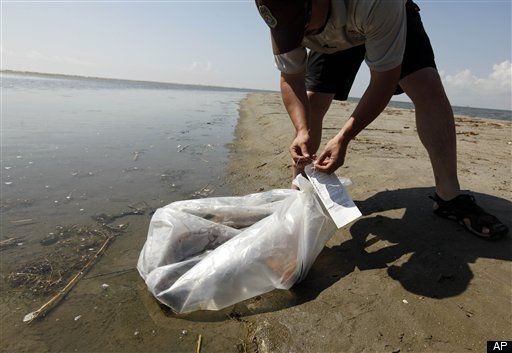
From the beginning down there in the Gulf of Mexico, nobody in an American generation raised on moon-shot success and Star Wars movies seemed to get it. The Deepwater Horizon disaster 50 miles off the Louisiana coast wasn't about a "spill.'' It wasn't about an Exxon Valdez hitting the rocks, gushing oil and becoming the mess Alaskans remembered all too well.
No, the Deepwater Horizon was from the beginning about the mess that could be, about the volcano of oil gushing from the ocean floor, about the possibility it would flow and flow and flow into the hundreds of millions of gallons and dwarf the Exxon Valdez.
Eleven million gallons -- the amount Joe Hazelwood's tanker spilled in Prince William Sound -- would have been bad in the Gulf of Mexico, but given that everything was taking place 50 miles offshore, it wouldn't have been that bad. The ocean is a big mixing bowl. German U-boats caused the equivalent spillage of about a dozen Exxon Valdez tankers off the East Coast in the early years of World War II, and no one really even noticed.
They were too preoccupied with the war. Oily water was a little thing. And none of the spill-related "toxins,'' as much of the media keeps referring to spilled oil now, ever showed any great affect at a human population level during or after the war. The toxins didn't stop a post-war baby boom or cause a disproportionate number of malformed babies to be born or shorten the American lifespan.
Life expectancy in America at the end of World War II was 65.9 years. It has gone up pretty steadily ever since the end of the war to the 75.2 years of today.
Despite all of the toxins in our environment -- as you read this people are merrily spreading them all over lawns in to kill weeds; you can smell the toxins in the air -- have shown no measurable effect at the human population level, it is not to say that they can't or that they won't or that an oil spill is not a bad thing. An oil spill is a very bad thing, but what is worse is an unstoppable gusher of oil nearly a mile deep beneath the ocean leaking ever more oil. The ocean can swallow and consume large quantities of crude. The Gulf of Mexico, in particular, after decades of oil drilling and oil transport, is filled with oil-eating microbes that feast on the stuff.
But there are limits to anything and everything.
Pollution is a dose-related issue. Water can prove toxic if you drink enough of it. Hyponatremia, sometimes called "water intoxication", was found to be the cause of death of 22-year-old runner David Rogers near the end of the 2007 London Marathon. He was not the first too die from drinking too much water.
Anything can be a toxin, but likewise most toxins can be diluted enough to render them generally harmless -- if, and here's the big if, if they can be diluted. And therein has been the BP oil problem since the beginning.
I was in the Gulf for AlaskaDispatch.com at the start of the Deepwater Horizon disaster. Everyone in there was worried about oil coming ashore, which didn't happen for weeks and still hasn't happened in the disastrous way Alaskans witnessed in Prince William Sound and along the Gulf of Alaska. But it was clear weeks ago, and has become more clear by the day, that if oil keeps flowing no volume of dispersants and no amount of burning can keep it from doing major ecological damage.
BP needs to plug the volcano. That was obvious a month ago. It is even more obvious now, with some speculating the flow of undersea oil has been steadily increasing since the Deepwater Horizon exploded April 20. There are plenty of reasons to believe that is the case. BP at first estimated something under 100,000 gallons of flow from three holes in a crimped pipe left broken beneath the rig that sank and killed 11 people.
One of those leaks was later capped. That focused the pressure of the undersea gusher on the other two openings. There are good reasons to believe that the pressurized, dirty oil and gas pouring out through those openings scoured them wider in the days after the spill. The National Oceanic and Atmospheric Administration in early May estimated the flow at more than 200,000 gallons per day. The number has only grown. The latest official guesstimate -- and everyone is guessing here whether their number is high or low -- is more than 500,000 gallons per day.
At this rate, with the estimated oil discharge closing in on a total of 21 million gallons as this is written, the Deepwater Horizon should reach Exxon Valdez-times-two by sometime Friday, if not sooner. But that's just the tip of the iceberg. Current, unsuccessful efforts to cap the well appear only to have made things worse, and BP isn't expecting to complete a relief well -- the only sure way to plug this mess -- until August.
The national media seems to be just catching on. They're starting to freak. They should.
I called this thing an Apollo 13 scenario from the beginning, and it is with one big difference. As everyone who saw the movie knows, NASA and a trio of very creative astronauts jury-rigged a solution to their navigational problem that managed to get the space capsule safely through the atmosphere and back to earth.